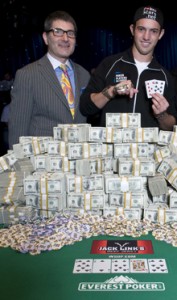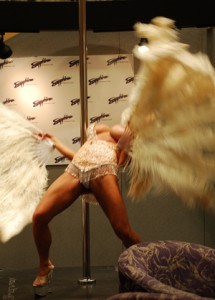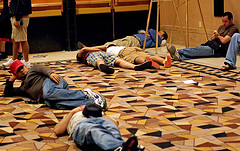 The dealer barely put down the deck on the 2009 WSOP when it was announced that Jeffrey Pollack, the World Series of Poker Commissioner, had resigned. In 2005, Harrah’s hired Pollack on as the Vice President of Marketing. In January 2006 he got bumped to the new position of WSOP Commish.
The dealer barely put down the deck on the 2009 WSOP when it was announced that Jeffrey Pollack, the World Series of Poker Commissioner, had resigned. In 2005, Harrah’s hired Pollack on as the Vice President of Marketing. In January 2006 he got bumped to the new position of WSOP Commish.
Pollack excelled on a number of fronts. Although in ’05 and ’06, the marketing end of his job wasn’t that difficult. In the post boom to pre-UIGEA era, marketing the WSOP was a sellers market. All Polack had to do was put bits and pieces of the WSOP up for sale and wait for the bidders. From online media rights, radio rights, the bracelets, playing cards, table felts, exhibitors’ booths, and TV “moment” sponsorships — companies lined up for the privilege.
Who could forget the Levitra final tables of 2005?
But once the UIGEA kicked in, finding mainstream sponsors to supplant the rich pocketbooks of online gaming companies wasn’t easy. Pollack plugged away and got the job done. While some people may mock Jack Link’s Beef Jerky as the 2009 WSOP presenting sponsor, finding any sponsor during the economic downturn was no small feat.
After the UIGEA, people were ready to stick a fork in poker. They (and I) argued that the UIGEA would accelerate the end of the poker boom. After all, in 2006, over half of the main event field was made up of online qualifiers. But after a down year in 2007, the WSOP was able to successfully build participation. In my opinion, that was a significant accomplishment.
Pollack had two other traits that served him — and the WSOP — well. He could blow smoke up anyone’s ass, especially his critics’. I knew hardened players and bloggers who were so angry about something WSOP-related. And yet after a brief chat with Pollack, they were converted into a sappy bevy of Sally Fields: “He likes me. He really likes me.” It was an awe-inspiring skill.
 Pollack also tried to learn from his mistakes. He made his fair share of them — but he worked hard not to make the same mistake twice.
Pollack also tried to learn from his mistakes. He made his fair share of them — but he worked hard not to make the same mistake twice.
Although the one mistake I think Pollack never rectified was the ousting of Matt Savage, and subsequently Johnny Grooms, in favor of a Tournament Director who would toe the company line. (No offense to Jack Effel, who has continued to successfully come up the learning curve) But Matt and Johnny had much firmer backbones when it came to defending the integrity of play amid company pressure. And hence, we got to see things like Hellmuth’s penalty overturned.
I also think that the WSOP’s preference to place “a company man” in the TD slot led to the two million extra chips getting introduced into the late stages of the 2006 WSOP main event. The error was a symptom of a less-experienced tournament staff under pressure. I do, however, pin the cover up on Pollack. Only after PokerNews told Harrah’s they were going to run the articles about the error did Pollack finally come clean about the screw up. Although to this day, Harrah’s has still failed to provide the details behind that potentially game-changing error — which happened during the largest sporting event in history.
But like I said, Pollack would work hard not to make the same mistake twice. After the PokerNews articles, the color-up procedure was changed. Color-ups are now performed at small number of tables at a time and provide for a real-time verification of the chip count.
Some other mistakes that were made, but addressed, include:
The Tent: Rather than tangle with Harrah’s web of bureaucracy to get more ballroom space for tournament play, the WSOP bought a $1 million tent in 2006. Climate control was impossible, and vacillated between artic and desert temperatures. It was also unsafe. Winds would start the lights swinging and supports swaying. Players, including Doyle Brunson, actually walked out of events rather than risk an accident. At one point, the tent had to be vacated — hours later it collapsed, the victim of high winds. The next year, there was no tent.
 The Cards: Under Pollack’s reign, everything was for sale, including the sponsorship of the cards. This is how we ended up with cards for the 2007 WSOP where it was almost impossible to tell a “6” from a “9.” So many players misread the cards in the very first hour of play, they had to be pulled from the WSOP — although not until enough decks could be brought in from Harrah’s locations across the country.
The Cards: Under Pollack’s reign, everything was for sale, including the sponsorship of the cards. This is how we ended up with cards for the 2007 WSOP where it was almost impossible to tell a “6” from a “9.” So many players misread the cards in the very first hour of play, they had to be pulled from the WSOP — although not until enough decks could be brought in from Harrah’s locations across the country.
The Strippers: After the UIGEA passed, Harrah’s was obviously a little hard-pressed to get exhibitors for its Lifestyle Show. In 2007, we ended up with sad palm readers and gentlemen’s clubs — including this stripper who had a wardrobe malfunction on the convention floor (pictured above). Complaints were many. Gentlemen’s clubs were excluded from the line-up in subsequent years.
Sequestered Final Tables: In 2007, Pollack sold the real-time broadcast rights to Bluff Magazine for the final tables that ESPN wouldn’t be televising. The set up precluded the players’ friends and family from viewing their final table appearance in person. In this post, the Poker Shrink explains the Sequestrium. Families who had flown in to see their son or daughter play, found themselves in a separate viewing room away from the action. Almost no one was present to see Phil Hellmuth win his record 11th bracelet. Eventually some seating was added to the “second-class” final tables.
 Registration: In 2007, the registration lines were miles long for the early events. Players missed hours of a tournament while they waited in line or waited as alternates (shown resting in the hallway, waiting for their time to play). After 2007, early registration was enhanced, more space was added, and more registration staff was hired to handle the early influx of players.
Registration: In 2007, the registration lines were miles long for the early events. Players missed hours of a tournament while they waited in line or waited as alternates (shown resting in the hallway, waiting for their time to play). After 2007, early registration was enhanced, more space was added, and more registration staff was hired to handle the early influx of players.
Registration Again: For some reason, the WSOP stopped showing registration numbers for the main event after 2004. They thought maintaining the drama of a “surprise” final player count was important. But this surprise backfired on them in 2009. Players were unaware that the final “Day One” schedule was filling to capacity, while earlier “Day Ones” still had room. As a result, the WSOP had to turn away 500 players on the last Day One of the WSOP – players who could have easily been accommodated in earlier Day Ones. It was a predictable problem with a number of potential solutions. By 2010, this will undoubtedly get addressed.
Being the commissioner of any sport isn’t easy. You have to try to pacify many fronts, all of which have competing interests. The public, the players (amateurs and pros), the media, the sponsors, and Harrah’s bottom line all made demands of Pollack.
Over all, I give Pollack a lot of credit. He managed to grow the WSOP’s participation after the UIGEA. Poker is still getting a lot ink in the mainstream media. And the introduction of the $50,000 H.O.R.S.E event was a phenomenal legacy.
It’s hard to balance the integrity of the event and the marketing demands of sponsors/your employer. To that end, I wished Pollack had erred more on the side of the former than the latter. And of course, I wish more care had been taken to develop a more effective media model.
I’ve seen posts suggesting both Matt Savage and Lee Jones as Pollack’s replacements. There are real benefits having someone with a demonstrated poker background take the helm. But the Commissioner’s job is first and foremost a marketing job. Whoever steps in also has to have a track record of signing big ad deals. As they said in the movie The Right Stuff, “No bucks. No Buck Rogers.”
Pollack brought in the bucks during some particularly challenging times. That continued to make the WSOP a valuable asset to Harrah’s. And on some level, that’s been a good thing for all of poker’s Buck Rogers.
One Comment